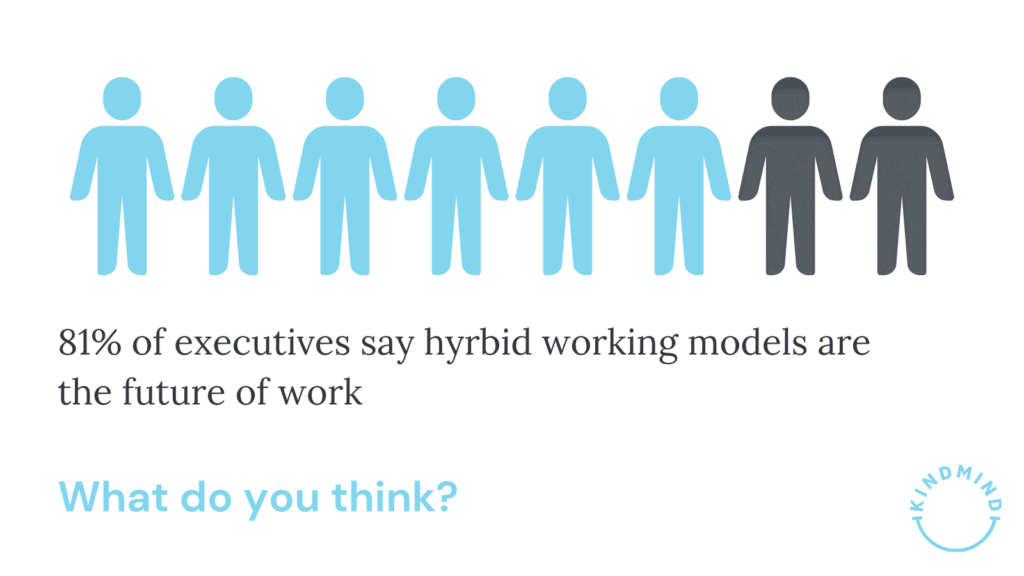Most experts agree that the hybrid working model leads the way for workforce productivity. But is it the best choice for your business?
This blog post will look at what we know about hybrid working practices and your business considerations in choosing them.
How has the hybrid working model changed over the last few years?
The hybrid work model, which involves working from home and in the office, has evolved significantly over the past few years. We have seen:
- Increased Adoption – The COVID-19 pandemic accelerated the adoption of hybrid work models, as many companies had to transition quickly to remote work. Many organisations realised the benefits of remote work during that time and are now incorporating it as a permanent part of their operations, albeit in a hybrid working model.
- Improved Technology – Widespread remote work has spurred the development of new tools and technologies designed to support remote collaboration and communication. For example, virtual meeting platforms like Zoom and Microsoft Teams have become essential for remote workers. At the same time, project management tools like Asana and Notion help teams keep track of tasks and stay organised.
- Greater Flexibility – Hybrid work has enabled employees to balance their work and personal life better, making the model more appealing.
- New Challenges – Companies need help maintaining a solid company culture, communication, and collaboration between remote and in-office workers.

In AT&T’s The State of the Industry: Future Work survey, 81% of senior executives said hybrid work will be the leading working model by 2024 despite its challenges. If this is true, 2023 will become an important year for organisations as they hammer down their policies.
68% of companies recently surveyed say they don’t yet have a detailed vision for their hybrid working model. Meaning there’s still a way to go before we reach projected futures. With a global recession on the horizon, it feels even more challenging to switch, but we believe the benefits outweigh the concerns.
Is anyone perfecting the hybrid working model yet?
That’s the big question – who can we learn from to inform our decision?
Several brands are often cited as having strong hybrid working models. These include:
- Microsoft – Microsoft has been a leader in the hybrid work movement, offering flexible work arrangements to its employees and enabling them to work remotely or in the office as needed.
- Apple – Apple’s journey to hybrid working wasn’t an easy path. Workers heavily resisted an initial 3-day office setup, but it has proved more popular once accepted.
- LinkedIn – LinkedIn has redefined their office experiences so that the important comfort and caring feelings staff get at home can also be enjoyed in the office. Meaning the jarring sensation of switching from home to office isn’t as harsh as it once felt.
How can their best practices inform your policy?
There is no one-size-fits-all answer to this question, as the best hybrid working model for you will depend on various factors, such as your company size, industry, and goals.
However, the key to your successful hybrid working policy is finding the right balance between remote and in-office work and supporting employees with the tools and resources they need to be productive and engaged.
So how do we do that? Let’s find out.
The 7 questions you need to ask to make sure hybrid working is right for your business
At Kind Mind, we believe there are several key questions you need to ask before you decide if hybrid work is right for your business.
1. How does your team feel about hybrid working and productivity?
The decision to go hybrid requires companies to get into the specifics. Organisations need to know what their employees think about it. Going hybrid will directly impact the work and life balance that employees have currently struck and value.
2. How does hybrid working affect management?
Successful management is about controlling the workforce whilst allowing employees a sense of autonomy. It’s a delicate balancing act! For a hybrid model to work, you need to assess how management can still manage successfully when employees aren’t always in the same location.
This might mean investing further into cloud systems to allow direction, support and governance.
3. What resources and structure do you need to go hybrid?
Working out what you need and where you need it will likely mean investing. However, being more concerned about your approach over costs could be a practical approach.
Take a look at your established systems and processes – what aids hybrid work going forward? What might give you better outcomes?
4. What are acceptable hybrid working spaces for your employees?
Hybrid working allows employees to work from either home or the office, and that’s not all. Many businesses are offering alternative work environments, such as co-working spaces.
WeWork studied this and found that the most satisfied employees worked in additional settings like cafes, libraries, or professional co-working offices.
The most crucial factor here is how you can offer various options that enhance employee performance whilst keeping your business safe.
It could also be taking a leaf out of LinkedIn’s approach by revamping the office experience to cause less friction between the switch.
5. Do you have the right tech in place?
In the past hybrid working would require custom systems and set-ups. Now, companies use widely available software and applications to complete their tasks making business functions easier.
HR departments are just one department taking advantage of new tech by using software to help coordinate employees in different settings. Tech here includes wellness applications, which allow you to monitor company health and culture (like our Kind Mind app).
6. What does inclusiveness and accessibility look like when employees are hybrid workers?
A hybrid working model allows companies to expand their talent pool by reaching geographically diverse candidates. It also helps to advance company goals around diversity, equity, and inclusion.
For example, HR tech becomes an outreach tool for remote workers. Quantifiable data allows you to very quickly determine how your employees are doing, how they are feeling and where their concerns are.
7. How do you manage employees’ wellness in a hybrid space?
A happy workforce is a productive one. Deloitte explains that one study conducted by a telecommunication company in the UK showed that happy employees worked faster and achieved 13% more sales.
It makes sense that you consider this.
When employees are in the office, it is much easier to spot problems, but at home, behind closed doors, it’s much more difficult.
A more open-door policy is one way to help employees to help themselves when they are struggling. But virtual one-to-ones and support procedures only go so far. In a hybrid space, you need tech to help you.
We’ve developed our wellness app based on remote and hybrid working situations to help your employees through happy and challenging times. Our software also gives you insights into staff wellness, advising on where to give more attention – enabling you to make more informed and effective decisions.
Your hybrid working model’s next steps
Once you have spent some time considering each of the factors we’ve laid out, it’s time for your next step – drafting your hybrid working model policy. We’ve got just the guide for you here.






